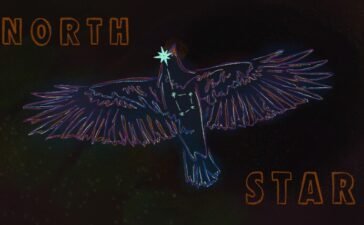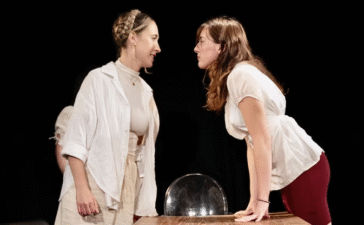The playwright, Leslie Kaplan, was gracious enough not only to invite me to meet her in her home tucked up on a hill near the Pantheon, but to read my translation and share her feedback. That spring, I traveled to the South of France to attend a production of another one of her plays from the Louise trilogy, where I saw the abstract ideas on the page embodied. Leslie set an incredibly high bar for my collaborative relationships with future francophone authors, and I am eternally grateful for this initiation into the world of translation. When I returned to the United States for my senior year of college, a student theatre company I ran with a couple friends staged my translation of Louise, she’s crazy, and it was the most radical thing I’ve ever had a hand in creating.
In the years since, I’ve translated fourteen more plays from French into English. Every play has brought its own opportunities and learnings, and many of them have forged lasting collaborative relationships with like-minded artists. Most of them have been commissions from French theatres and festivals, such as L’Alliance New York (formerly FIAF), Princeton University’s Seuls en Scène French theater festival, the City University of New York’s Caribbean Theatre Project, the Théâtre Raymond Kabbaz in Los Angeles, and Sibikwa Arts Centre in South Africa. A few commissions came directly from playwrights, including Alain Foix, Eva Doumbia, and Sedef Ecer. Some plays have received staged readings, several have been published, and a full production of Eva Doumbia’s Autophagies (Self-Eaters) toured the United States in 2023.
One of the greatest strengths of the theatre in translation niche in the United States is the generosity of our collectives.
Translation creates a throughline between worlds and fosters relationships; and immersing myself in theatre in translation communities has not only improved my understanding of theatrical craft, but also world history and global politics. Throughout this series, Translators on Theatre: In Our Own Words, fellow theatre translators will share their perspectives on the most pressing issues and promising initiatives within our field. There is no singular journey—language is so personal—and making sense of one’s place in the broader cultural ecosystem requires interactions with multicultural, intergenerational community. Luckily, one of the greatest strengths of the theatre in translation niche in the United States is the generosity of our collectives.
Translation Collectives and Networks
My journey through theatrical translation has been bolstered—even made possible—by the strength of networks such as the Fence, founded by Jonathan Meth in 2003. Neil Blackadder and Adam Versényi’s contribution to this series, an essay on advocacy strategies to bring increased visibility to theatre in translation, includes several other collectives available to theatre translators. Jennifer Croft writes in her excellent translator-centric novel, The Extinction of Irena Rey, “Translators always have these networks, not like writers. Writers compete.” This resonates with my own experience, having cut my teeth on both playwriting and translating plays. I only found my theatrical home once I got into a room full of people who also felt like they never belonged in one place. People who felt most comfortable in the in-between, making sense of the liminal space, inviting others to travel with them between languages, cultures, and realities. Who couldn’t be confined to one theatrical tradition, who shared a sense of dramatic wanderlust, a restlessness in their creative spirit. Language is an imperfect portal, but it’s a portal, nonetheless.
Questioning my own linguistic choices has taught me to see with others’ eyes and hear with others’ ears, which has improved not only my translation skills but also my writing.
I’ve never understood the “traduttore, traditore” (“The translator is a traitor”) curse, which accuses translators of betraying the original text’s meaning because it is impossible to perfectly ferry ideas, depth, and nuance across languages. Instead, I’ve always known translation to be an act of service. In multilingual groups, such as gatherings of the Fence network, I have often found myself in the role of de facto interpreter, allowing the francophone members of the group to participate more fully in the conversation by whispering a running current of language. Particularly in theatre translation, creative solutions to unwieldy language are the mark of an adept translator. Why should the translator be blamed for the discrepancies between the source and target languages? And where would we be without them, without us? Lost in a sea of words with no shore in sight.
My experience translating plays has provided endless lessons in humility and creativity, as well as the strength of collaborative work. Amanda Andrei shares her pathway through the portal in her essay for this series on how to get started translating a play, including the value of calling on community. Questioning my own linguistic choices has taught me to see with others’ eyes and hear with others’ ears, which has improved not only my translation skills but also my writing. Moreover, dramatic translation teaches the courage that comes from asserting your artistic choices, understanding that translation is not an exercise in binary right and wrong, but rather interpretation.
It’s easy to feel defeated by the perceived lack of interest in our creative work, given the dearth of funding, programming, crediting, and publication in the United States.
These skills make translators invaluable dramatic collaborators, schooled in empathy as well as the granularity of language and expression. In their contribution to this series, Jeremy Tiang makes an impassioned argument that theatre translators rightfully belong in the rehearsal room, not only in recognition of their artistry and creative practice, but also in service of the play itself. We are long accustomed to being our authors’ and our plays’ ambassadors and, as such, being veritable repositories of context, history, and cultural meaning for our plays. Our labor has been undervalued for far too long.
Moving Together, Growth is Slow
Who is this practice for, and why do translators collectively continue to invest so much effort into these plays’ immigration processes? A gathered group of theatre translators will always bemoan the broader US theatre scene’s lack of interest in our work. Why do we care so much about this, and why does everyone else care so little?
Veteran theatre translators Jean Graham-Jones and Caridad Svich, in their conversation on translation and adaptation for Translators on Theatre: In Our Own Words, express the widely shared frustration at how little has changed over twenty years of advocating for more theatre in translation in the United States. As a relative newcomer to these conversations, I have nevertheless spent a decade conversing in the same circles, and it’s easy to feel defeated by the perceived lack of interest in our creative work, given the dearth of funding, programming, crediting, and publication in the United States.






